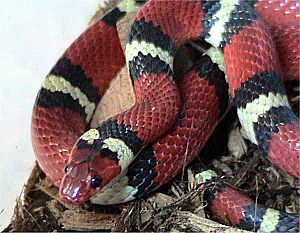Kingsnake facts for kids
Quick facts for kids Kingsnake |
|
|---|---|
 |
|
| Scarlet kingsnake, Lampropeltis triangulum elapsoides | |
| Scientific classification | |
| Kingdom: | |
| Class: | |
| Order: | |
| Family: | |
| Genus: |
Lampropeltis
|
Kingsnakes are a group of snakes that belong to the Lampropeltis genus. This group also includes milk snakes. You can find many different types of kingsnakes. They live mostly in the United States and Central America.
Kingsnakes are known for their special hunting skills. They are also famous for their clever way of protecting themselves.
Contents
All About Kingsnakes
Kingsnakes are a type of snake in the Lampropeltis family. This family includes many different kinds of kingsnakes. It also includes milk snakes. Scientists are still learning about all the different types. Most kingsnakes live in the United States and Central America.
Clever Camouflage: Looking Like Dangerous Snakes
Kingsnakes have amazing colors and patterns. Their skin often looks a lot like the patterns of dangerous coral snakes. This is a special trick called Batesian mimicry. It helps kingsnakes stay safe.
Birds and other animals that eat snakes see the bright colors. They think the kingsnake is a poisonous coral snake. This makes them stay away. So, the kingsnake is protected without being venomous itself!
What Do Kingsnakes Eat?
Kingsnakes are very good hunters. They kill their food by squeezing it tightly. This is called constriction. They are not picky eaters and will eat many different things.
Their favorite food is often other snakes! This includes venomous snakes like rattlesnakes. The "king" in their name comes from this habit. Just like the king cobra, they are "kings" because they eat other snakes. Kingsnakes are known to be immune to the venom of snakes from their own areas.
Besides other snakes, kingsnakes also enjoy eating lizards, rodents, birds, and even eggs. They are truly opportunistic eaters!
Super Strong Squeezers!
Kingsnakes are incredibly strong for their size. For example, the California kingsnake can squeeze its prey twice as hard as some other snakes. This includes snakes like ratsnakes and pythons.
Scientists think this amazing strength helps them hunt other snakes and reptiles. These animals can hold their breath for a long time. So, a super strong squeeze helps the kingsnake quickly stop their prey from breathing.
Who Preys on Kingsnakes?
Even kingsnakes can become prey for other animals. Large birds, like hawks and eagles, often hunt kingsnakes. Sometimes, even big Tarantula spiders might try to catch a young kingsnake.
Images for kids
-
California kingsnake (Lampropeltis californiae)
-
Eastern kingsnake (Lampropeltis getula getula)
See also
 In Spanish: Serpiente real para niños
In Spanish: Serpiente real para niños





